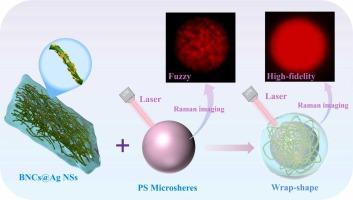用于微弯曲目标高保真可视化拉曼成像的柔软和包裹状nanofibers@plasmonic SERS传感器
IF 3.7
1区 化学
Q1 CHEMISTRY, ANALYTICAL
引用次数: 0
摘要
对于表面增强拉曼散射光谱(SERS)来说,一个挑战是如何实现与微弯曲样品足够接近的共形附着衬底,从而促进特定目标的拉曼成像。在此,我们提出了一种简单而有效的方法,通过在1D细菌纳米纤维素(bcs)上的二维等离子体银纳米片(NSs)的各向异性原位生长来生产柔软的包裹状SERS传感器。最优的BNCs@Ag纳米粒子在加宽的激光波长下具有宽带和高SERS活性,有利于在~10-15 M飞摩尔水平上的检测限(LOD)。此外,也证实了整个平台具有良好的空间SERS均匀性,相对标准偏差(RSD)为5.1%。在纤维支架的作用下,干燥状态下的独立柔性BNCs@Ag NSs膜,经过适当的润湿处理,可以很容易地软化成粘接膜。它赋予BNCs@Ag NSs在任意形状目标的微观曲线表面上具有保形适应性和独特的粘附固定,使其能够完全包裹并紧密捕获3D聚苯乙烯(PS)微球。值得注意的是,智能SERS传感器能够对单个或多个分离的PS微球进行高保真拉曼成像,展示微弯曲样品的鲁棒性和精确的SERS可视化。因此,突出了特殊的双重优点:1)为常规柔性SERS基板领域提供补充功能,这些基板不可能或难以与微翘曲目标进行保形接触或牢固集成;2)弥补了胶体纳米粒子用于定量SERS可视化的固有缺陷,即在复杂曲线物体上普遍存在聚集导致的SERS空间均匀性差。本文章由计算机程序翻译,如有差异,请以英文原文为准。

Soft and wrap-like nanofibers@plasmonic SERS sensors for high-fidelity visualized Raman imaging of micro-curved targets
As for surface-enhanced Raman scattering spectroscopy (SERS), a challenge is how to achieve conformally attachable substrates that can get close enough to micro-curved samples, promoting Raman imaging of specific targets. Herein, we propose a simple yet efficient approach to produce soft and wrap-like SERS sensors by anisotropic in-site overgrowth of 2D plasmonic Ag nanosheets (NSs) on 1D bacterial nanocelluloses (BNCs). The optimal BNCs@Ag NSs with exhibit broadband and high SERS activities under broadened laser wavelengths, facilitating the limit of detection (LOD) at ~10-15 M femtomole level. Besides, the excellent spatial SERS uniformity with relative standard deviation (RSD) < 5.1% throughout whole platform is also confirmed here. By virtue of the fibrous scaffolds, the free-standing flexible BNCs@Ag NSs films at dry state can be very easily softened into adhesive membranes after appropriately wetting process. It endows BNCs@Ag NSs with conformal adaptability and distinctive adhesive fixation on microscopic curvilinear surfaces of arbitrary-shaped targets, enabling them to fully wrap and intimately capture 3D polystyrene (PS) microspheres. Notably, the smart SERS sensors are capable of high-fidelity Raman imaging of individual or multiple-isolated PS microspheres, demonstrating robust and precise SERS visualization of micro-curved samples. So, the exceptional double-merits are then highlighted: 1) affording a complementary feature to the field of routine flexible SERS substrates that are impossible or difficult to conformally contact or firmly integrate with micro-warped targets; 2) compensating the inherent deficiency of colloidal nanoparticles used in quantitative SERS visualization that suffer from the ubiquitous aggregation-induced poor spatial SERS uniformity on complex curvy objects.
求助全文
通过发布文献求助,成功后即可免费获取论文全文。
去求助
来源期刊

Sensors and Actuators B: Chemical
工程技术-电化学
CiteScore
14.60
自引率
11.90%
发文量
1776
审稿时长
3.2 months
期刊介绍:
Sensors & Actuators, B: Chemical is an international journal focused on the research and development of chemical transducers. It covers chemical sensors and biosensors, chemical actuators, and analytical microsystems. The journal is interdisciplinary, aiming to publish original works showcasing substantial advancements beyond the current state of the art in these fields, with practical applicability to solving meaningful analytical problems. Review articles are accepted by invitation from an Editor of the journal.
 求助内容:
求助内容: 应助结果提醒方式:
应助结果提醒方式:


